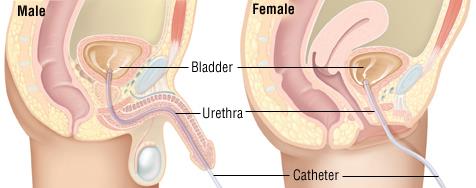
Intermittent catheters help people with compromised bladder function in draining urine from the bladder. They provide assistance where natural draining of urine is not possible. Although intermittent catheterization is a widely preferred procedure, it has its own challenges and risks. Through this article you will learn how to overcome the challenges and minimize the risks associated with intermittent catheterization. It contains some easy steps which are to be followed when you encounter basic catheterization issues.

If you find it difficult to insert the intermittent catheter, you are advised to relax and take some deep breaths. Try coughing slightly when inserting the catheter. If still you are unable to insert the catheter, do not force it inside. Remove the catheter and try inserting it again after an hour. In case your bladder is full and you are feeling uneasy, seek for medical assistance immediately.
Usually the intermittent catheter comes out by relaxing. If you find it difficult to remove the catheter, try coughing. In case the bladder mucus is stuck in the eyes of the catheter, you can rotate the intermittent urinary catheter to help ease removal.
Catheter irritating the bladder or pressure on the bladder due to constipation can result in stomach cramps. These cramps are commonly known as bladder spasms. If bladder spasms occur due to irritation of the bladder, you need to consult your healthcare provider immediately.
Signs and symptoms of a urinary tract infection (UTI) are as follows:
If you see any of these symptoms, consult your healthcare provider immediately. He might take a urine sample for laboratory testing. Urine sample should always be taken after changing the catheter for accurate results. Your healthcare provider will suggest you a course of antibiotics to treat the urinary tract infection. By increasing the amount of fluid intake, unless suggested otherwise by your healthcare provider, you can quickly flush the bacteria out of the system.
Except following some surgical procedures on the bladder or prostate, there should not be any blood present in the urine. If you find any blood in the urine, consult your healthcare professional immediately. Occasionally, there might be a small amount of bleeding if the intermittent catheter has irritated your urethra. It is usual and there is no need to panic. Talk to your doctor if bleeding is heavy or continuous.
Disclaimer: All content found on our website, including images, videos, infographics and text were created solely for informational purposes. Our content should never be used for the purpose of diagnosis or treatment of any medical conditions. Content shared on our websites is not meant to be used as a substitute for advice from a certified medical professional. Reliance on the information provided on our website as a basis for patient treatment is solely at your own risk. We urge all our customers to always consult a physician or a certified medical professional before trying or using a new medical product.